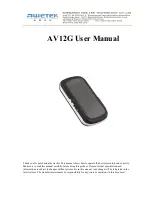
Post-Installation Configuration & Checkout
Apollo CNX80 Installation Manual
560-0982-00 Rev D
3-23
d)
If required, clear the “
WARNING Stuck Microphone
” message by pressing the
CLR
bezel
key. Repeat steps b) and c) for additional frequencies as follows.
121.150 MHz
131.225 MHz
121.175 MHz
131.250 MHz
121.185 MHz
[1]
131.275
MHz
121.190 MHz
[1]
130.285
MHz
[1]
121.200 MHz
131.290 MHz
[1]
121.225 MHz
131.300 MHz
121.250 MHz
131.325 MHz
131.200 MHz
131.350 MHz
[1] frequency is only applicable to VHF radios with 8.33 kHz channel spacing
e)
Repeat for each com transmitter installed in the aircraft.
f)
If aircraft is TCAS-equipped, turn on the TCAS system and verify that GPS position remains
valid (if position is lost, NO POSITION FIX is displayed in place of the position data).
g)
If aircraft is SATCOM-equipped, use the SATCOM system and verify that GPS position
remains valid (if position is lost, NO POSITION FIX is displayed in place of the position
data).
h)
If the CNX80 is susceptible to VHF Com transmitter interference, then better isolation (or greater
separation) may be required between the GPS and VHF (or other offending system)
antennas. With
some com transmitters, a 1575.42 MHz notch filter (such as Garmin AT P/N 162-1059) may be
required in series with the VHF Com antenna coax at the rear of the com unit. ELT’s may re-radiate
harmonics of the VHF Com signal into the GPS band. A 1575.42 MHz notch filter on the ELT will
solve this.
NOTE
Older VHF Com transmitters may emit higher levels of harmonic interference causing
greater problems and may be more difficult to deal with.
3.3.2.2 VHF Nav Checkout
Press the
CDI
bezel key to select VOR CDI mode (indicated by a green VOR in the left portion of the
CNX80 CDI display). To the right of the VOR indication is the current setting of the OBS. Verify that the
OBS decodes properly from 0 to 360 degrees (the value displayed on the CNX80 should be within
±
2
°
of
the OBS). Check the operation of remote VOR flip-flop switch (if installed).
Check the VOR reception with ground equipment, operating VOT or VOR, and verify audio and Morse
code ID functions (if possible). Tune a Localizer frequency and verify the CDI needle and NAV flag, and
VDI needle and GS flag operation.
NOTE
Some VOR test equipment may not be compatible with the digital signal processing of the
VHF Nav receiver and will give erroneous results. Examples of equipment known to
function properly are: IFR Nav 750 and Collins 479S-6.
3.3.2.3 VHF Com Checkout
3.3.2.3.1 Antenna Check
If desired, the antenna VSWR can be checked using an inline wattmeter in the antenna coax using
frequencies near both ends of the band. The VSWR should be < 2:1, and is not to exceed 3:1. A VSWR of
2:1 will cause a drop in output power of approximately 12%, and 3:1 causes approximately a 26% drop.
Содержание Apollo CNX80
Страница 1: ...Apollo CNX80 Installation Manual September 2003 560 0982 00 Rev D...
Страница 10: ...Table of Contents viii 560 0982 00 Rev D Apollo CNX80 Installation Manual NOTES...
Страница 30: ...General Information 1 20 560 0982 00 Rev D Apollo CNX80 Installation Manual NOTES...
Страница 41: ...Installation Procedures Apollo CNX80 Installation Manual 560 0982 00 Rev D 2 11 Figure 2 3 CNX80 Dimensions...
Страница 106: ...Post Installation Configuration Checkout 3 34 560 0982 00 Rev D Apollo CNX80 Installation Manual NOTES...
Страница 114: ...Periodic Maintenance 6 2 560 0982 00 Rev D Apollo CNX80 Installation Manual NOTES...
Страница 133: ...Appendix D Interconnect Diagrams Apollo CNX80 Installation Manual 560 0982 00 Rev D D 1 APPENDIX D INTERCONNECT DIAGRAMS...
Страница 134: ...Appendix D Interconnect Diagrams D 2 560 0982 00 Rev D Apollo CNX80 Installation Manual NOTES...
Страница 164: ...Appendix E Acceptable Aircraft by Evaluation E 2 560 0982 00 Rev D Apollo CNX80 Installation Manual NOTES...
Страница 166: ...Appendix F Optional Accessories Not Supplied F 2 560 0982 00 Rev D Apollo CNX80 Installation Manual NOTES...
Страница 167: ......
Страница 168: ......















































